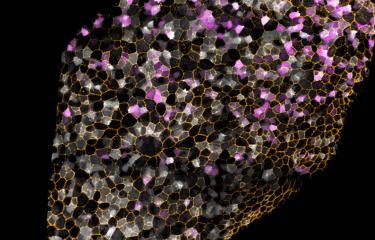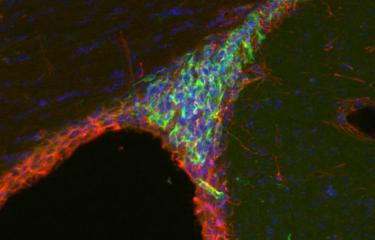A team of hematology marrow transplant department of the Saint-Louis Hospital AP-HP, the Paris University and INSERM (U976 unit) in collaboration with the Pasteur Institute, led the work on graft against host disease (GVHD) using liquid chromatography coupled with mass spectrometry to study the metabolome of allogeneic patients at Saint-Louis hospital AP-HP. The results of these studies highlight major changes in the human metabolome after allograft, associated with the patient's metabolism alterations and its microbiota, and could represent new potential therapeutic targets for the prevention or treatment of GVHD. They were the subject of a publication December 13, 2019 in the journal Nature Communications.
Allogeneic hematopoietic stem cell (HSC) is a curative treatment used for many hematologic malignancies and congenital or acquired anomalies of hematopoiesis. Despite the improvement in the management of patients, allogeneic HSCT remains associated with severe immunological complications. Graft against the host (GVHD) is a major complication that may occur after a allograft, and is characterized by tissue damage induced by donor immune cells which react against those of the recipient. Recent advances in the understanding of immunological mechanisms of GVHD have shown that activation of donor immune cells is tightly regulated by the microenvironment tissue or digestive microbiota changes after transplantation.
Recently, metabolomics has emerged as a new field of biology that reflects how genetics, environment or microbiota affect the biochemical processes of an individual. In this project, the team of Dr. David Michonneau and Professor Gérard Socié (INSERM U976 / Saint Louis Hospital AP-HP / University of Paris) was interested in the study of the metabolome of allogeneic patients in the hospital Saint- Louis AP-HP in the hematology-transplant adult service. Using the liquid chromatography-high performance mass spectrometry, they were able to study the metabolome of 43 patients who developed acute GVHD or not after an allograft. These data were confirmed using a second independent national multicenter cohort, from the collection of biological resources Cryostem (ANR / INCA).
Through this approach, they were able to show that acute GVHD is associated with a decrease in the path of tryptophan metabolites and arginine, as well as lipids family plasmalogens, the lysoplasmalogènes and phospholipids. Conversely, patients with acute GVHD had high rates of complex lipids, such as fatty acids to medium or long-chain, polyunsaturated fatty acids and bile acids. In allograft patients, decreased plasmalogens and increased bile acids and polyunsaturated fatty acids may contribute to the pro-inflammatory response early cause of acute GVHD. Indoles derivatives, a group of metabolites produced by the microbial metabolism of tryptophan, were also among the more impaired in patients with acute GVHD. Indoles derivatives are ligands of the receptor Aryl Hydrocarbon (AhR), which regulates the activation and differentiation of immune cells and could therefore contribute to limiting the risk of immune reaction to allogeneic origin of GVHD.
These results published in the journal Nature Communications highlight the major changes in the human metabolome after allograft, associated with alterations of the patient's metabolism or its microbiota, which may represent potential therapeutic targets new for the prevention or treating the graft against the host (GVHD).
*All molecules produced by metabolism of an individual or his microbiota
Sources
Metabolomics analysis of human acute Graft-versus-Host Disease reveals changes in host and microbiota-derived metabolites, Nature communications, December 13th, 2019
David Michonneau1,2,9, Eleonora Latis3,9, Emmanuel Curis 4,5,6, Laetitia Dubouchet2, Sivapriya Ramamoorthy7, Brian Ingram7, Régis Peffault de Latour1,2, Marie Robin1 , Flore Sicre de Fontbrune1, Sylvie Chevret6,8, Lars Rogge3,10 & Gérard Socié1,2,10
1Hematology Transplantation, Saint Louis Hospital, 1 avenue Claude Vellefaux, 75010 Paris, France.
2Université de Paris, INSERM U976, 75010 Paris, France.
3Institut Pasteur, Immunoregulation Unit, Department of Immunology, 25 rue du Docteur Roux, 75015 Paris, France.
4Université de Paris, INSERM UMR-S1144, 75013 Paris, France.
5Université de Paris, Laboratoire de biomathématiques plateau iB2EA 7537–BioSTM, Faculté de pharmacie, 75006 Paris, France.
6Service de Biostatistique et Information Médicale, Hôpital Saint-Louis, AP-HP, 1 avenue Claude Vellefaux, 75010 Paris, France.
7Metabolon, Inc., Morrisville, NC, USA.
8Université de Paris, INSERM U1153, Epidemiology and Biostatistics Sorbonne Paris Cité Research Center (CRESS), ECSTRA Team, 75010 Paris, France.
9These authors contributed equally: David Michonneau, Eleonora Latis.
10These authors jointly supervised this work: Lars Rogge, Gérard Socié.




